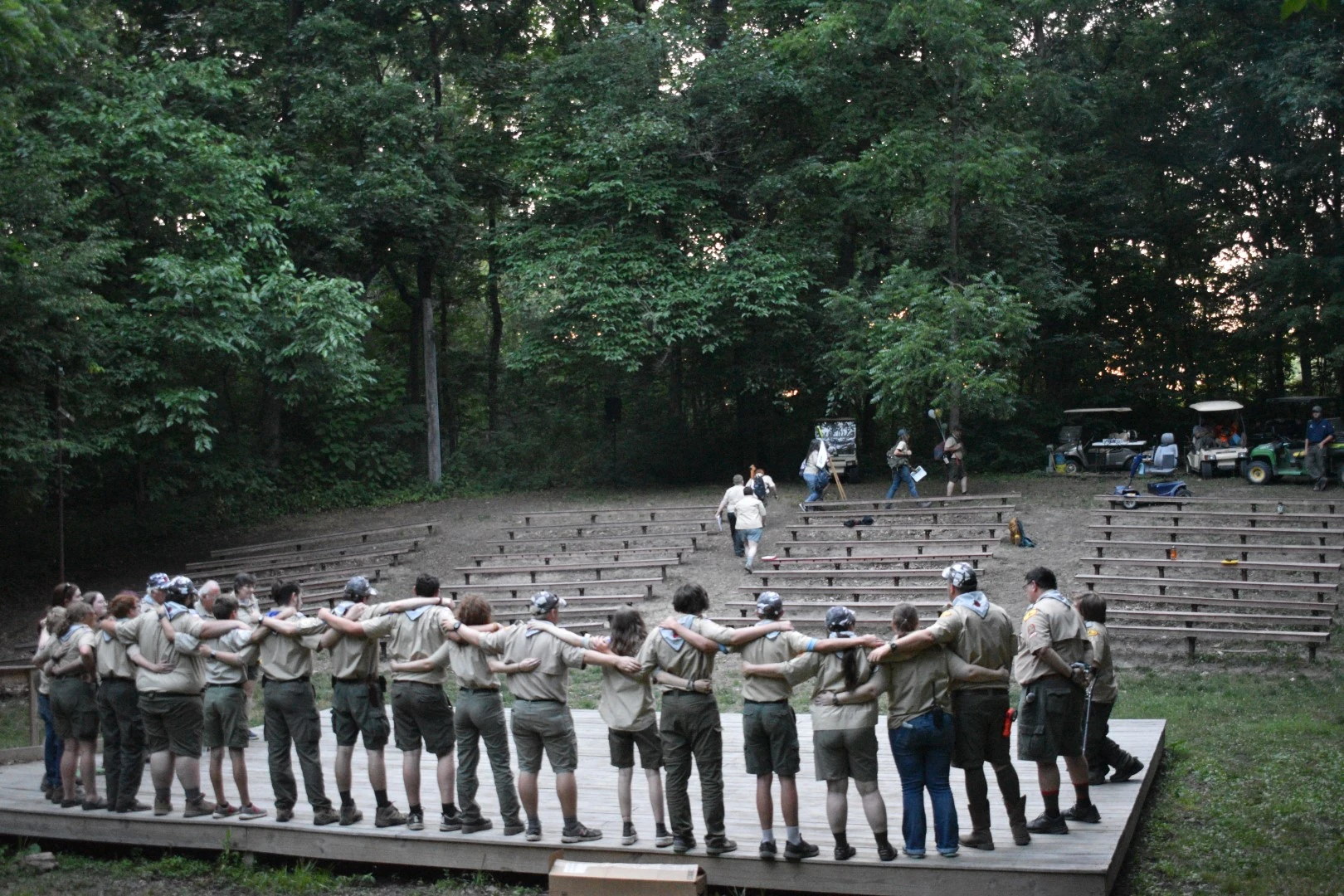
History of Camp Buffalo
Since 1945, Camp Buffalo has been a Scout camp for tens of thousands of Scouts. For each generation of Scouts, it has fulfilled the needs of the Scouting program. Today, you can take a Scout from each generation and find many things on camp are still the same, while many things on camp have changed. IN a sense, Camp Buffalo has been like a living and breathing organism that changes as the Scouting program changes. One example of these changes can be found in the aquatics program at camp. When it was first founded, Camp Buffalo used a waterfront access to the Tippecanoe River as the main swimming and boating area. Later on, a swimming pool was added for an easier and cleaner swimming experience. Lastly, Liberty Lake was added to the southeast end of the property to supplement the pools swimming area and allow for boating. While the aquatic area has changed, the use of the Tippecanoe River waterfront still remains for Scouts and Scouters who wish to take a canoe or float trip down the river.
Camp Buffalo has remained the home of great memories for many Scouts and Scouters. But it all had to start from somewhere. In 1944, the Logansport Council purchased the land for $10,000. In 2020, that would be about $150,000. Because of the war effort during WWII, the Logansport Council did not use Camp Buffalo as the summer camp in 1944. In the summer of 1945, Camp Buffalo was first used for summer camp.
in 1951, the Lodge Hall as it was called, or more appropriately Muehlhausen Lodge, was dedicated. This structure served as the dining hall and meeting center through the summer of 2007. During this time, other buildings were built on the property and thousands of pine trees were planted on the property in the early years. The Logansport Council became the Three Rivers Council and in the late 1960s’ held a huge capital campaign called “Forward For Boys”. The purpose of this capital campaign was to raise money for additional land to be purchased, to build a new warehouse, and to put in a swimming pool. In 1970, Three Rivers Council purchased an additional 144 acres of land for $50,000. This land was east and north of the original 118 acres.
While many things were accomplished for camp by Scouting volunteers, some aspects of camp were done by outside help. The former Bunker Hill Air Force Base, now Grissom Air Reserve Base, played a vital role in the development of Camp Buffalo. The second rifle range on camp was engineered and built by the base and they also donated many pots and pans that can sill be found on camp today.
In the early 1970s, BSA councils were seeking a decline in membership and costs were rising. The National Office had General Motors propose a plan to consolidate, or merge, councils. This helped eliminate some duplication of employees and possible properties. The plan that was presented to Three Rivers Council was that everyone in that council area shops in Fort Wayne, so they should merge with Fort Wayne. Two other area councils, Meshingomesia, out of the Marion and Kokomo areas, and Harrison Trails, out of the Lafayette area, were suggested to merge with another council. None of the three councils liked the GM plan, so all three merged into the Sagamore Council which officially started in January 1973. With the merger came four camp properties, Camp Buffalo, Cary Camp, Green Hills (which was undeveloped farmland), and Crossland Scout Reservation. in 1973, Sagamore Council ran about 16 weeks of summer camp between the camps. Each had their own staff or shared small parts of staff. Troops were encouraged to visit the other two properties outside their former council camp. A few did but most did not.
in late January 1977, a massive blizzard hit Indiana. Again, in late January 1978m another larger blizzard hit Indiana. The effects of these two blizzards weakened the dining hall structure at Camp Buffalo and the roof trusses broke under the weight of the snow. By the end of 1978, the future of Camp Buffalo was uncertain. There was no ranger on the property and it just sat empty. Summer camp was not scheduled there in 1979 and the future of Camp Buffalo did not look good. Spearheaded by Bill Shideler of Logansport and Ernie Hiatt of Rochester, they got approval to try and fix the roof. The old roof was removed and a new trussed roof was installed. The result was the dining hall was remodeled and used as the dining hall until 2007 when it was remodeled and turned into the Multi-Purpose building.
In 1981, a single camp staff was hired for the Council. The camp staff then rotated between the three camp properties to put on a summer camp at each one. During the rotation, two weeks of summer camp was held at Camp Buffalo. Howard Drake, along with his wife Armilda, was hired to work as the Camp Ranger. So, summer camp, ran for a few years and then again, due to forces within the council, it was decided to no longer have a summer camp program. A group of troops from Logansport, who referred to themselves as Tipicon Campers, rented the camp and held their own summer camp program for several years. By the mid 1990s, Crossland Scout Reservation was sold to the state of Indiana, and Camp Buffalo became the main summer camp of Sagamore Council. As more Scouts attended summer camp, the fireplace which separated a former office and trading post from the dining area in the dining hall was removed to expand the dining hall.
In the mid 1990s, the Property Committee was tasked to take a long-term look at the dining hall situation. The current dining hall was not large enough to support the summer camp program. It was decided to build a new dining hall at Camp Buffalo. Construction began in 2006 and by 2008, the new dining hall as finished and ready for use during summer camp. The Council named the new dining hall, Shideler Hall, in honor of long-time scouter William (Bill) Shideler who had been a driving force in improving Camp Buffalo.
Over time, society and Scouting has changed and so Camp Buffalo has changed to keep up with it all. Today, with computers and other electronic devices that are more common, Camp Buffalo has fiber optic internet that comes into camp and Wi-Fi that is spread to most of the buildings and some campsites around camp. At one time, nearly all troops cooked out in the campsites during summer camp. Today, they all eat in the dining hall except for Wednesday night dinner and Thursday morning breakfast.
One of the unique things about Camp Buffalo is that most everything done at the camp has been done with volunteer labor under the supervision of a few individuals. From Shideler Hall, the total gutting and remodeling of the Multi-Purpose Building, to the Pines Shower House, Ivey Lodge, Eel Inn, Winter Quarters, Indoor Archery Range, Shooting Sports ranges, Nature Building, and more. Without volunteer labor and donation of much needed material, this would not have been possible.
Would those first Scouts who stepped foot onto Camp Buffalo in 1945 have ever imagined what camp is today? For a scout who wen there first in 1969, then saw what happened by the end of the 1970s, and to see Camp Buffalo today as a great place for summer camp, it is exciting that we are celebrating it’s continued success and beyond.
Adapted from Camp Buffalo: A History of Camp Buffalo – 2021 75th Anniversary Edition (2021). To purchase a copy, please contact us!
